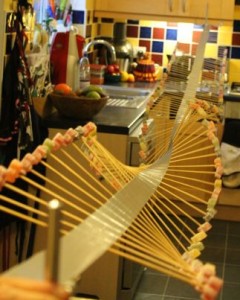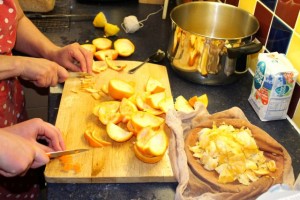Libby has been working her way through the Physics IGCSE course from Sam Martell and got to the section about waves. There are some excellent resources (see my other article on YouTube Videos) out there but nothing quite beats building a wave machine to explore the motion of waves directly. We went to the Bradford science fair a year or so ago and saw something there that we just had to have a got at building.
 It’s basically a long piece of duct tape with bamboo skewers stuck to it and jelly babies stuck to the skewers. When you suspend the tape and wiggle one of the skewers at one end it causes a transverse wave to propagate down the line. The waves will exhibit all the expected behaviours just like any wave does it’s just in a non-conventional medium! It’s perfect for playing with waves and you can eat the jelly babies afterwards if you want. It was pointed out that you don’t need to use jelly babies and the at something more permanent could be used and that is true but it’s not as engaging as making science edible, in my opinion. So if you fancy having a go, try following these instructions and take a look at the video we made on youtube (links are all below). So onwards…
It’s basically a long piece of duct tape with bamboo skewers stuck to it and jelly babies stuck to the skewers. When you suspend the tape and wiggle one of the skewers at one end it causes a transverse wave to propagate down the line. The waves will exhibit all the expected behaviours just like any wave does it’s just in a non-conventional medium! It’s perfect for playing with waves and you can eat the jelly babies afterwards if you want. It was pointed out that you don’t need to use jelly babies and the at something more permanent could be used and that is true but it’s not as engaging as making science edible, in my opinion. So if you fancy having a go, try following these instructions and take a look at the video we made on youtube (links are all below). So onwards…
First your going to need some basic equipment:
- A roll of duct tape long enough to do twice the length you’re planning.
- Bamboo skewers
- Jelly Babies (more than you think! as some get eaten)
- 2 metal rods or thick wood dowels for anchor points at each end.
- Tape measure
- Clamp stands or some way of suspending it at each end.
Our pile looks like this on the right.
Start by laying out the skewers on the tape, 5cm apart. Mark the middle of each stick and make sure you line up the middle of the stick with the middle of the tape and keep them perpendicular tot he tape.
Do it alongside a ruler and when you reach the end lay another stretch of duck tape over t he top of the skewers to keep them in place. We used a second role of tape and kept them both running continuously.
Alex and Libby kept at the layout of sticks
Cassie worked on marking the middle of the skewers. We anchored a metal bar at both ends
 And when we were done the whole tape was 4.5m long. We then rolled it up to make hanging easier.
And when we were done the whole tape was 4.5m long. We then rolled it up to make hanging easier.
Then using a couple of lab stands clamped to the kitchen bench and table…
 We loaded the jelly babies. As we did so we noticed that not all jelly babies are the same and this caused the sticks to start to hang lower on one side than the other so we went for colour pairs, putting only the same colour sweet on the same skewer. This seemed to balance things nicely.
We loaded the jelly babies. As we did so we noticed that not all jelly babies are the same and this caused the sticks to start to hang lower on one side than the other so we went for colour pairs, putting only the same colour sweet on the same skewer. This seemed to balance things nicely.
 Once all the skewers had a jelly baby stuck on each end your done. Make sure it does not sag too much by pulling the ends out a bit.
Once all the skewers had a jelly baby stuck on each end your done. Make sure it does not sag too much by pulling the ends out a bit.
 And give it its first wiggle by moving the end of a skewer at one on up and down to start a wave. The tension and weight of the set up will only want to go so fast, so as long as you’re not brutal with it, you can send a beautiful wave down the length and reflection at the other end will send it back.
And give it its first wiggle by moving the end of a skewer at one on up and down to start a wave. The tension and weight of the set up will only want to go so fast, so as long as you’re not brutal with it, you can send a beautiful wave down the length and reflection at the other end will send it back.
Finally we made a video of the machine in action. It’s here on youtube.
So I hope you have fun making your own and do email or leave comments letting us know how you got on.










